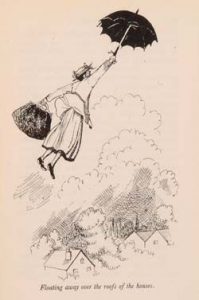 From Nurse Matilda to Nanny McPhee to Mary Poppins to Jane Eyre, the governess or nanny has proved to be a fascinating character in literature, and mystery fiction has it’s share of them. Interestingly, both Nurse Matilda and Nanny McPhee where created by mystery writer Christianna Brand (1907-1988), beloved by mystery readers for her Inspector Cockrill novels. Here are a few of my “nanny” favorites.
From Nurse Matilda to Nanny McPhee to Mary Poppins to Jane Eyre, the governess or nanny has proved to be a fascinating character in literature, and mystery fiction has it’s share of them. Interestingly, both Nurse Matilda and Nanny McPhee where created by mystery writer Christianna Brand (1907-1988), beloved by mystery readers for her Inspector Cockrill novels. Here are a few of my “nanny” favorites.
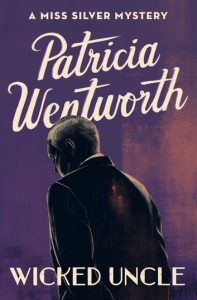 Patricia Wentworth’s sleuth, Miss Sliver, is a former governess, so the lions’ share of governesses come from her pen. While Miss Silver is now a comfortably employed inquiry agent, she retains some of her governessy characteristics and appearance, a great advantage when she aspires to invisibility within a household where a murder has taken place. Two of my favorites are Wicked Uncle (a.k.a. Spotlight, 1947) where penniless Dorinda Brown takes a job as governess to a spoilt little boy. It’s rare to have the governess be the main protagonist, and this is one of the few examples. The suspense is provided by Dorinda’s fear of her “wicked uncle” who turns out to be her new employer’s neighbor. He is so unpleasant he is of course murdered, but this is one of the most charming of Wentworth’s books.
Patricia Wentworth’s sleuth, Miss Sliver, is a former governess, so the lions’ share of governesses come from her pen. While Miss Silver is now a comfortably employed inquiry agent, she retains some of her governessy characteristics and appearance, a great advantage when she aspires to invisibility within a household where a murder has taken place. Two of my favorites are Wicked Uncle (a.k.a. Spotlight, 1947) where penniless Dorinda Brown takes a job as governess to a spoilt little boy. It’s rare to have the governess be the main protagonist, and this is one of the few examples. The suspense is provided by Dorinda’s fear of her “wicked uncle” who turns out to be her new employer’s neighbor. He is so unpleasant he is of course murdered, but this is one of the most charming of Wentworth’s books.
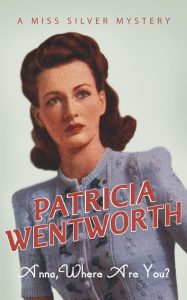 I am also a fan of Anna, Where Are You? (A.k.a. Death at Deep End, 1951), which is an oddball entry in Wentworth’s long series. Anna, the nanny to a houseful of children, has vanished, and Miss Silver goes undercover to take her place. The genesis of this series had more of an espionage bent which comes out in a few of the later novels, though most of them remain comfortably within the country house tradition. This one has an espionage element to it along with the country house setting. One of my favorite parts of this novel, along with the unusual setting (the country house is part of an artistic “commune”) was seeing Miss Silver at work in her original occupation. She of course sets the children to rights along with solving the mystery.
I am also a fan of Anna, Where Are You? (A.k.a. Death at Deep End, 1951), which is an oddball entry in Wentworth’s long series. Anna, the nanny to a houseful of children, has vanished, and Miss Silver goes undercover to take her place. The genesis of this series had more of an espionage bent which comes out in a few of the later novels, though most of them remain comfortably within the country house tradition. This one has an espionage element to it along with the country house setting. One of my favorite parts of this novel, along with the unusual setting (the country house is part of an artistic “commune”) was seeing Miss Silver at work in her original occupation. She of course sets the children to rights along with solving the mystery.
 Nine Coaches Waiting by Mary Stewart (1958) also unusually foregrounds a governess. Young, penniless, orphaned Linda Martin takes a job as governess to the Comte de Valmy, who lives in a literal French castle in the gorgeous countryside. Things seem fine at first and then degenerate as the swirling surface tensions take on a more sinister tone, but it’s not until an accident nearly kills her charge that Linda realizes her fears are all horribly true. One of the true delights of reading a Mary Stewart gothic is the prose, which is absolutely lovely. It’s a wonderful bonus that goes along with the great stories she tells.
Nine Coaches Waiting by Mary Stewart (1958) also unusually foregrounds a governess. Young, penniless, orphaned Linda Martin takes a job as governess to the Comte de Valmy, who lives in a literal French castle in the gorgeous countryside. Things seem fine at first and then degenerate as the swirling surface tensions take on a more sinister tone, but it’s not until an accident nearly kills her charge that Linda realizes her fears are all horribly true. One of the true delights of reading a Mary Stewart gothic is the prose, which is absolutely lovely. It’s a wonderful bonus that goes along with the great stories she tells.
 Agatha Christie doesn’t foreground a governess in too many of her books, though they often appear as characters. One crucial and ultimately tragic governess appears in Crooked House (1947). Janet Rowe is nanny to the wealthy Leonides family, who are being torn apart by the death of the family patriarch by an insulin overdose. All the branches of the family live under one roof, and little Josephine, Miss Rowe’s charge, figures prominently in the mystery. I won’t give away the ending but as it was published in 1947 I assume many of you have read it already! This is one of my favorite Christie novels, though it’s neither a Poirot or a Marple.
Agatha Christie doesn’t foreground a governess in too many of her books, though they often appear as characters. One crucial and ultimately tragic governess appears in Crooked House (1947). Janet Rowe is nanny to the wealthy Leonides family, who are being torn apart by the death of the family patriarch by an insulin overdose. All the branches of the family live under one roof, and little Josephine, Miss Rowe’s charge, figures prominently in the mystery. I won’t give away the ending but as it was published in 1947 I assume many of you have read it already! This is one of my favorite Christie novels, though it’s neither a Poirot or a Marple.
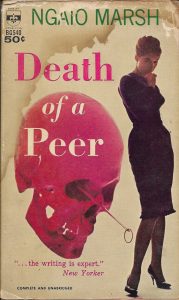 While “nanny” is not a main character in Ngaio Marsh’s classic Death of a Peer (a.k.a. Surfeit of Lampreys, 1940) she is an important one, effectively running the household of the chaotic and charming Lamprey family. In debt to their eyeballs and hoping for a bail out by Lord Lamprey’s titled elder brother, the brother is instead murdered in the elevator of their apartment building. Nanny keeps things on track, making sure the young Lampreys are bathed and fed and put to bed on time. She still tells the elder Lamprey children how to behave and as she’s nanny, they actually listen to her. An audience with nanny is a required part of any family visit. While unspoken, her disapproval can be obvious. She is definitely in the classic nanny mold.
While “nanny” is not a main character in Ngaio Marsh’s classic Death of a Peer (a.k.a. Surfeit of Lampreys, 1940) she is an important one, effectively running the household of the chaotic and charming Lamprey family. In debt to their eyeballs and hoping for a bail out by Lord Lamprey’s titled elder brother, the brother is instead murdered in the elevator of their apartment building. Nanny keeps things on track, making sure the young Lampreys are bathed and fed and put to bed on time. She still tells the elder Lamprey children how to behave and as she’s nanny, they actually listen to her. An audience with nanny is a required part of any family visit. While unspoken, her disapproval can be obvious. She is definitely in the classic nanny mold.
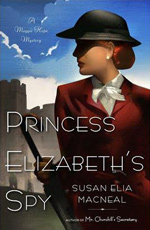 One of my favorite mysteries, Susan Elia MacNeal’s Princess Elizabeth’s Spy (2012) finds her protagonist, Maggie Hope, undercover as a math tutor to the young Princess Elizabeth. The plot turns on Maggie’s (and young Elizabeth’s) skill with codes as Maggie protects the Princess from a Nazi plot. While Maggie isn’t really a governess she does serve as one, and MacNeal uses the Princess’ actual nanny and governess, Alah and Crawfie, as characters in the novel. This is a blast of a read.
One of my favorite mysteries, Susan Elia MacNeal’s Princess Elizabeth’s Spy (2012) finds her protagonist, Maggie Hope, undercover as a math tutor to the young Princess Elizabeth. The plot turns on Maggie’s (and young Elizabeth’s) skill with codes as Maggie protects the Princess from a Nazi plot. While Maggie isn’t really a governess she does serve as one, and MacNeal uses the Princess’ actual nanny and governess, Alah and Crawfie, as characters in the novel. This is a blast of a read.
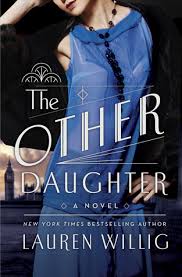 Another favorite nanny protaganist, actually the main character, appears in Lauren Willig’s The Other Daughter (2015). Willig often has two threads to her novels, one in the present and one in the past, but this one takes place fully in the 1920’s with no timeline deviation. I was lucky enough to have it with me on a long flight and devoured the entire book in one sitting. Young Rachel Woodley, who is -naturally – impoverished, has been working as nanny to a French family when she gets word that her mother is very ill and rushes to be with her. Because her employer, who found her impending absence inconvenient, had withheld the letter about her mother, Rachel arrives too late. The rest of the novel finds the grieving Rachel attempting to unearth family secrets.
Another favorite nanny protaganist, actually the main character, appears in Lauren Willig’s The Other Daughter (2015). Willig often has two threads to her novels, one in the present and one in the past, but this one takes place fully in the 1920’s with no timeline deviation. I was lucky enough to have it with me on a long flight and devoured the entire book in one sitting. Young Rachel Woodley, who is -naturally – impoverished, has been working as nanny to a French family when she gets word that her mother is very ill and rushes to be with her. Because her employer, who found her impending absence inconvenient, had withheld the letter about her mother, Rachel arrives too late. The rest of the novel finds the grieving Rachel attempting to unearth family secrets.
Nannies, though they still exist, are a far less common way for impoverished young women to find work nowadays. They aren’t the feature they were in a British country house where golden age mysteries took place. A novelist like Willig, who delves greedily and gorgeously into the past, can certainly supply a nanny character for readers but to find them now, we have to look backwards. They were the perfect household observers, wonderful clay for the detection toolbox.